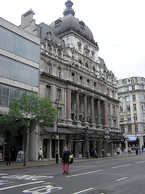Her Majesty's Theatre
Charles John Phipps
alias Queen's Theatre, Italian Opera House, King's TheatreHaymarket, | Wikipedia, arthurlloyd.co.uk, The Victorian Web, british-history.ac.uk, The Theatres Trust |
| show on the map | http://www.hermajestystheatre.co.uk/ |
Important events
"The building was burnt down in less than an hour. The fire broke out at eleven o'clock at night, and it seems that the alarm was rather slow in communicating with the headquarters of the brigade, then located in Watling Street. It was said that the alarm was not given until twenty minutes past eleven, by which time the flames had attacked the roof. By midnight the scene had become one of fearful grandeur, when the roof collapsed amid a shower of sparks and fragments which fell like so much hail in front of the clubs in Pall Mall. Several houses round the theatre were gutted, principally the shops in the adjoining Opera Arcade. " IN: Mander, Raymond a Mitcheson, Joe. The theatres of London.London, 1963 p. 106- 107
People
English dramatist and architect, in which latter capacity he was responsible for the design of the first Queen's Theatre on the site of the present Her Majesty's. This was built to house a company led by Betterton, who appeared there in Vanbrugh's own play, The Confederacy (1705), based on Dancourt's Les Bourgeoises a la mode (1692) and often billed as The City Wives' Confederacy. But Vanbrugh's best plays are undoubtedly The Relapse; or, Virtue in Danger (1696), a sequel to and parody of Love's Last Shift (also 1696), by Cibber , and The Provoked Wife (1697).
IN: Hartnoll, Phyllis, ed. The concise Oxford companion to the theatre. 1st ed. London: Oxford University Press, 1972. ISBN 0-19-281102-9. p. 570
History
A contemporary description states:
"On the ground floor, level with the street, will be found Orchestral Stalls, Pit Stalls and the Pit. The first floor will be devoted to the Dress Circle and Family Circle. The second tier consists of the Upper Circle, Amphitheatre and the Gallery behind. The five doorways in the centre of the Haymarket fa9ade under-neath the loggia open into a vestibule exclusively for the use of the two classes of the Stalls and the Dress and Family Circles, and the Stalls have a third way out, level with the pavement in Charles Street. . . . The style adopted for the auditorium of the theatre is Louis XIV. There are private boxes on each of the tiers adjoining the proscenium and separated from it and other parts of the auditorium by marble columns. The hangings are of cerise-coloured embroidered silk and the walls generally are covered with a paper of the same tone. The seating for Stalls, Dress and Family Circles is in arm chairs, covered with velvet the same colour as the curtains. The Tableau curtains are of velvet of a similar tone behind which is the Act Drop of tapestry copied from one of the Gobelin Tapestries now in Paris. The whole of the theatre and annexes are lighted by the Electric Light taken from three centres, so that should any one centre fail, the other systems are always available. Hanging from the ceiling is a cut glass and brass electrolier and brackets of Louis XIV style are fixed round the box fronts and on the side walls. "
In: Mander, Raymond and Mitcheson, Joe. The theatres of London. London, 1963 p. 107 - 108
Authors: Raymond Mander, Joe Mitcheson
Raymond Mander:
Her Majesty's Theatre, Adelphi Theatre, London Palladium, Palace Theatre, Gielgud TheatreAdditional information
No information has yet been entered
Add information































